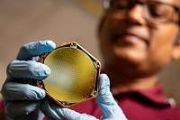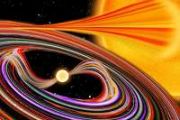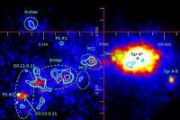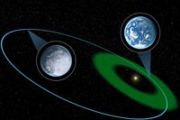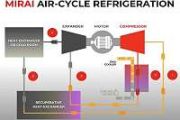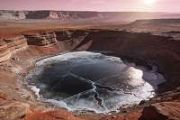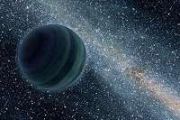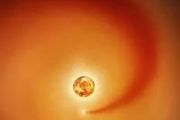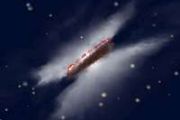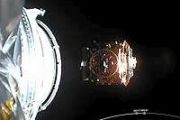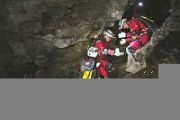
Copernical Team
ESA awards development contract for NanoMagSat

Today, the ESA awarded a contract to Open Cosmos to design, build, launch and commission the NanoMagSat Scout satellites. This new mission will uphold Europe’s leadership in monitoring Earth’s magnetic field and contribute to applications such as space weather hazard assessment, navigation, directional drilling, and more.
HESS Observatory identifies highest-energy cosmic-ray electrons and positrons yet observed
 Scientists from CNRS, a German university consortium, and the Max-Planck-Institut fur Kernphysik working at the H.E.S.S. Observatory in Namibia have detected cosmic-ray electrons and positrons with the highest energies ever recorded, exceeding 40 TeV. This significant discovery reveals new insights into cosmic processes that produce immense energy, although their origins remain unclear. These re
Scientists from CNRS, a German university consortium, and the Max-Planck-Institut fur Kernphysik working at the H.E.S.S. Observatory in Namibia have detected cosmic-ray electrons and positrons with the highest energies ever recorded, exceeding 40 TeV. This significant discovery reveals new insights into cosmic processes that produce immense energy, although their origins remain unclear. These re XRISM mission looks deeply into 'hidden' stellar system
 The Japan-led XRISM (X-ray Imaging and Spectroscopy Mission) observatory has captured the most detailed portrait yet of gases flowing within Cygnus X-3, one of the most studied sources in the X-ray sky.
Cygnus X-3 is a binary that pairs a rare type of high-mass star with a compact companion - likely a black hole.
"The nature of the massive star is one factor that makes Cygnus X-3 so
The Japan-led XRISM (X-ray Imaging and Spectroscopy Mission) observatory has captured the most detailed portrait yet of gases flowing within Cygnus X-3, one of the most studied sources in the X-ray sky.
Cygnus X-3 is a binary that pairs a rare type of high-mass star with a compact companion - likely a black hole.
"The nature of the massive star is one factor that makes Cygnus X-3 so Record-breaking run on frontier sets new bar for simulating the universe in the exascale era
 The universe just got a whole lot bigger - or at least in the world of computer simulations, that is.
In early November, researchers at the Department of Energy's Argonne National Laboratory used the fastest supercomputer on the planet to run the largest astrophysical simulation of the universe ever conducted.
The achievement was made using the Frontier supercomputer at Oak Ridge Nat
The universe just got a whole lot bigger - or at least in the world of computer simulations, that is.
In early November, researchers at the Department of Energy's Argonne National Laboratory used the fastest supercomputer on the planet to run the largest astrophysical simulation of the universe ever conducted.
The achievement was made using the Frontier supercomputer at Oak Ridge Nat NASA selects SpaceX for Dragonfly mission to Titan
 NASA has officially awarded SpaceX the contract to provide launch services for its highly anticipated Dragonfly mission, part of the New Frontiers Program. This innovative mission will send a rotorcraft lander to Titan, Saturn's largest moon, to explore its unique geologic settings and search for clues about the origins of life.
Valued at approximately $256.6 million, the firm-fixed-price
NASA has officially awarded SpaceX the contract to provide launch services for its highly anticipated Dragonfly mission, part of the New Frontiers Program. This innovative mission will send a rotorcraft lander to Titan, Saturn's largest moon, to explore its unique geologic settings and search for clues about the origins of life.
Valued at approximately $256.6 million, the firm-fixed-price Novel supernova observations grant astronomers a peek into the cosmic past
 An international team of researchers has made new observations of an unusual supernova, finding the most metal-poor stellar explosion ever observed.
This rare supernova, called 2023ufx, originated from the core collapse of a red supergiant star, exploded on the outskirts of a nearby dwarf galaxy. Results of the study showed that observations of both this supernova and the galaxy it was dis
An international team of researchers has made new observations of an unusual supernova, finding the most metal-poor stellar explosion ever observed.
This rare supernova, called 2023ufx, originated from the core collapse of a red supergiant star, exploded on the outskirts of a nearby dwarf galaxy. Results of the study showed that observations of both this supernova and the galaxy it was dis A clue to what lies beneath the bland surfaces of Uranus and Neptune
 Diamond rain? Super-ionic water? These are just two proposals that planetary scientists have come up with for what lies beneath the thick, bluish, hydrogen-and-helium atmospheres of Uranus and Neptune, our solar system's unique, but superficially bland, ice giants.
A planetary scientist at the University of California, Berkeley, now proposes an alternative theory - that the interiors of bo
Diamond rain? Super-ionic water? These are just two proposals that planetary scientists have come up with for what lies beneath the thick, bluish, hydrogen-and-helium atmospheres of Uranus and Neptune, our solar system's unique, but superficially bland, ice giants.
A planetary scientist at the University of California, Berkeley, now proposes an alternative theory - that the interiors of bo Uranus moons could hold clues to hidden oceans for future space missions
 NASA's upcoming mission to Uranus aims to explore the icy moons first photographed by Voyager 2 in 1986, this time seeking evidence of subsurface oceans that could potentially harbor life. Researchers from the University of Texas Institute for Geophysics (UTIG) are developing advanced tools to support the mission, including a computer model designed to detect hidden oceans using data from spacec
NASA's upcoming mission to Uranus aims to explore the icy moons first photographed by Voyager 2 in 1986, this time seeking evidence of subsurface oceans that could potentially harbor life. Researchers from the University of Texas Institute for Geophysics (UTIG) are developing advanced tools to support the mission, including a computer model designed to detect hidden oceans using data from spacec Earthbound asteroids may be tracked more precisely using new equation
 Tracking potentially hazardous asteroids with greater precision may now be achievable thanks to a novel equation for calculating their orbits more accurately.
Building on concepts introduced by Sir Isaac Newton and advanced by Albert Einstein's general relativity, researchers have devised a method to pinpoint the positions of minor solar system objects, such as asteroids, Kuiper Belt objec
Tracking potentially hazardous asteroids with greater precision may now be achievable thanks to a novel equation for calculating their orbits more accurately.
Building on concepts introduced by Sir Isaac Newton and advanced by Albert Einstein's general relativity, researchers have devised a method to pinpoint the positions of minor solar system objects, such as asteroids, Kuiper Belt objec From space to atmosphere scientists unravel secrets of asteroid 2022 WJ1
 Scientists led by Lowell Observatory's Dr. Teddy Kareta have made remarkable strides in characterizing near-Earth asteroids (NEAs) by combining telescopic observations with fireball camera data. Their study, published in 'The Planetary Science Journal', focuses on asteroid 2022 WJ1, integrating data from the Lowell Discovery Telescope (LDT) in Arizona and meteor observation cameras in Ontario, C
Scientists led by Lowell Observatory's Dr. Teddy Kareta have made remarkable strides in characterizing near-Earth asteroids (NEAs) by combining telescopic observations with fireball camera data. Their study, published in 'The Planetary Science Journal', focuses on asteroid 2022 WJ1, integrating data from the Lowell Discovery Telescope (LDT) in Arizona and meteor observation cameras in Ontario, C 


